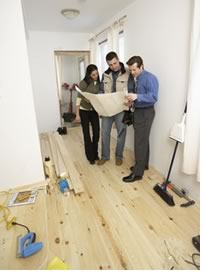

07/2005
by Jim. W. Sealy, FAIA
In my work as a litigation consultant, lawyers repeatedly ask me the same questions: “What do architects know about slip resistance?” and “What makes you an authority on slip resistance?” I give the same answer to both questions and it’s very simple: “Who is more qualified to address slip resistance than an architect?”
 I then explain to them that architects imagine, plan, and then embody
their ideas in buildings and facilities. Except for those parts of buildings
that are classified as “equipment,” it is difficult for me
to think of an area that will not have a floor or a walking surface of
some description, and architects are the geneses of floors and walking
surfaces. Floors are an integral part of the complete designs that architects
conceive, so they must understand the principles of slip resistance to
complete their designs. Along with this naturally comes an understanding
of what could cause a person to fall when the surface upon which they
are walking has what some perceive to be a low slip resistance factor.
I then explain to them that architects imagine, plan, and then embody
their ideas in buildings and facilities. Except for those parts of buildings
that are classified as “equipment,” it is difficult for me
to think of an area that will not have a floor or a walking surface of
some description, and architects are the geneses of floors and walking
surfaces. Floors are an integral part of the complete designs that architects
conceive, so they must understand the principles of slip resistance to
complete their designs. Along with this naturally comes an understanding
of what could cause a person to fall when the surface upon which they
are walking has what some perceive to be a low slip resistance factor.
That’s a lengthy answer and always results in: “Objection, nonresponsive” (I get that a lot). What the lawyers mean is that my answer does not fit into their overall plan of attacking my credibility. They want to establish that a slip-and-fall suffered by their client occurred because of a “violation of the slip resistance factors caused by a low coefficient of friction” and do not believe that an architect can address that subject. These lawyers have been (or have allowed themselves to be) misled into thinking that only a person who has a degree in “human factors” or mechanical engineering—or who has attended at least one continuing education course in coefficients of friction—can be an expert in slips and falls. Obviously, I disagree with this premise and stick to my answer.
 In today’s age of specialization, an architect remains one of
the closest examples of a “Renaissance Man” that can be found
(of course many architects are women, but “Renaissance Person” just
doesn’t sound right to me). Until the advent of sophisticated mechanical
and electrical systems, architects designed every aspect of buildings
and often even supervised construction. Primarily because of the threat
of litigation, architects have had to give up the actual hands-on design
of certain parts of their buildings and relinquish any control over the
actual construction process. However, they must still have a substantial
knowledge of all the disciplines that come together in their designs.
In today’s age of specialization, an architect remains one of
the closest examples of a “Renaissance Man” that can be found
(of course many architects are women, but “Renaissance Person” just
doesn’t sound right to me). Until the advent of sophisticated mechanical
and electrical systems, architects designed every aspect of buildings
and often even supervised construction. Primarily because of the threat
of litigation, architects have had to give up the actual hands-on design
of certain parts of their buildings and relinquish any control over the
actual construction process. However, they must still have a substantial
knowledge of all the disciplines that come together in their designs.
The “acceptable” coefficient
of friction
There is a long-standing dictum that the “acceptable” coefficient
of friction is 0.5. Several prominent agencies and organizations (the
National Institute of Standards and Technology, ASTM International, Underwriters
Laboratories, et al.) accept this as the baseline for denoting a reasonable
coefficient of friction for a single material. However, determining an
actual slip resistance factor is not just determining the coefficient
of friction of a single product. This is where it gets confusing for
the lawyers: knowing the slip resistance factor of a walking surface
is not as simple as selecting a material that has a coefficient of friction
in the range of 0.5. Slip resistance is actually the combination of the
coefficients of frictions of at least two materials.
Slip resistance is the result of one surface striking another. In other words: if an architect selects a material for the walking surface with a coefficient of friction of 0.5, what is to prevent Cinderella from walking on it in her shiny, slick, glass slippers? Nothing—and if that happens, the walking surface suddenly becomes “unacceptable” because the bottoms of her slippers are slick and do not have a compatible coefficient of friction with the floor material. The result of Cinderella’s little stroll can be a slip that may result in a fall, but that does not mean that the flooring material that was selected had an insufficient coefficient of friction and thereby contributed to the fall.
 Does that mean that the only thing architects have to consider is the
coefficients of friction of the materials they select for the walking
surfaces of their buildings? No, it doesn’t—but it also does
not mean that an architect must take into account every conceivable scenario
that may result when one material strikes another. That is a fallacy
and the totally unreasonable premise that the lawyers espouse when they
claim that an architect does not understand coefficients of friction
or the resultant slip resistance premises that apply to designs.
Does that mean that the only thing architects have to consider is the
coefficients of friction of the materials they select for the walking
surfaces of their buildings? No, it doesn’t—but it also does
not mean that an architect must take into account every conceivable scenario
that may result when one material strikes another. That is a fallacy
and the totally unreasonable premise that the lawyers espouse when they
claim that an architect does not understand coefficients of friction
or the resultant slip resistance premises that apply to designs.
Not only do those lawyers not understand architects, the experts they hire mislead them by pointing out tables in books and reports and saying, “See here? Had the material they specified complied with the appropriate coefficient of friction, this person obviously would not have fallen.” Some experts even align themselves with standards-writing organizations and get themselves placed on committees that deal with subjects such as coefficients of friction.
This is a shrewd move but only superficially effective because the standards addressing coefficients of friction and flooring surfaces do not apply to construction unless a jurisdiction specifically adopts the standard, and very few actually do. Most prefer to believe that such standards are for designers’ in-house use and never adapt them to their own methods of enforcement.
 Before you start to think that I am oversimplifying this issue, consider
the rest of the story. Not only is the slip resistance factor a product
of two surfaces striking one another, it can also include the complications
of “contamination.” A contaminant can be either on the walking
surface or on the element—in this case, the sole of the shoe—striking
the walking surface. A contaminant can take many forms, from spilled
liquid to a wet leaf or a chewing gum wrapper. Anything that comes between
the surface being struck and the striking element can result in the total
elimination of any reasonable semblance of slip resistance. For example,
I have been involved in lawsuits that involved floors that had perfectly
acceptable coefficients of friction by themselves but were contaminated
by spilled grease. Is that a reason to fault the people who selected
and installed the flooring materials? No, it is an issue of whether or
not the floor was properly cleaned after the spill.
Before you start to think that I am oversimplifying this issue, consider
the rest of the story. Not only is the slip resistance factor a product
of two surfaces striking one another, it can also include the complications
of “contamination.” A contaminant can be either on the walking
surface or on the element—in this case, the sole of the shoe—striking
the walking surface. A contaminant can take many forms, from spilled
liquid to a wet leaf or a chewing gum wrapper. Anything that comes between
the surface being struck and the striking element can result in the total
elimination of any reasonable semblance of slip resistance. For example,
I have been involved in lawsuits that involved floors that had perfectly
acceptable coefficients of friction by themselves but were contaminated
by spilled grease. Is that a reason to fault the people who selected
and installed the flooring materials? No, it is an issue of whether or
not the floor was properly cleaned after the spill.
This leads me to a related point. I will not be so brash as to speak for the U.S. Access Board, but it is my opinion that it does not consider coefficients of friction something that must be addressed under its accessibility guidelines. After all, access for the disabled does not hinge on the slip resistance of a walking surface. The majority of the disabled are concerned with safe access to buildings and facilities, and what may be an acceptable coefficient of friction for one disabled person has the possibility of resulting in unsafe access for another. Consider persons who cannot lift their feet as they walk. A surface that is considered slip-resistant could actually cause those persons’ feet to lock in place, making them lose their balance and fall. In an instance like that, the selection of a material that possesses an “acceptable” slip resistance factor is meaningless. This is what I try to explain to lawyers who challenge my qualifications to address slip resistance and coefficients of frictions.
 Says who?
Says who?
Not only do lawyers regularly question my qualifications, they want me
to show them where my opinions have been subjected to peer review,
published in a scientific journal, etc. My reply is that coefficients
of friction and slip resistance have never been codified. About the
only references you will find are when people claim that they are required
because they are mentioned in the federal accessibility guidelines.
I then cite a letter written in 1993 by U.S. Department of Justice
(DOJ) Public Access Section Chief John Wodatch to South Carolina Senator
Ernest F. Hollings, who had been asked by one of his constituents why
the DOJ was not doing something about overly slick walking surfaces.
Wodatch replied, in part:
Section 4.5.1 of the Americans with Disabilities Act Accessibility Guidelines requires ground and floor surfaces along accessible routes and in accessible rooms and spaces to be stable, firm, and slip-resistant. There are no enforceable standards for coefficients of friction in the regulations. The Appendix to the Guidelines, which is advisory only, discusses recommended coefficients of friction in section A4.5.1. Because coefficients of friction for flooring materials in place can be affected by water, cleaning compounds, or other factors, and because it is difficult to measure these coefficients under varying environmental conditions, the recommended coefficients are provided only as advisory guidance and not as regulatory requirements.
 It
is my opinion that this supports my position with regard to slip
resistance. Moreover it is my opinion that most of the lawsuits that
raise the issue of slip resistance are out there because a few attorneys
and a limited number of self-serving experts want us to believe that
it is a critical point of concern, whereas, in all but the rarest cases,
the real issues are simply ones of common sense. In either case, architects
remain the most qualified individuals to address the subjects of slip
resistance and coefficients of friction.
It
is my opinion that this supports my position with regard to slip
resistance. Moreover it is my opinion that most of the lawsuits that
raise the issue of slip resistance are out there because a few attorneys
and a limited number of self-serving experts want us to believe that
it is a critical point of concern, whereas, in all but the rarest cases,
the real issues are simply ones of common sense. In either case, architects
remain the most qualified individuals to address the subjects of slip
resistance and coefficients of friction.
Don’t misunderstand me. I am not advocating that anyone ignore
slip resistance. I’m saying that testing devices and tables of
data are used by some to cloud common-sense evaluations of real-world
situations. Yes, there have been and will continue to be a small number
of design professionals who themselves fail to exercise common sense
when choosing the materials used for walking surfaces. However, that
does not mean that a slip-and-fall incident should automatically lead
to a lawsuit just because the coefficient of friction of a flooring material
is close to or even less than a “magic” value appearing in
a table—thereby allowing the material to be declared slick and
dangerous.
Copyright 2005 The American Institute of Architects.
All rights reserved. Home Page ![]()
![]()
 |
||
This article originally appeared in the June 2005 issue of Building Safety Journal, and is copyright 2005 by the International Code Council. It is reprinted here with permission. Jim. W. Sealy, FAIA, is an architect and consultant in Dallas whose expertise ranges from planning and zoning and conceptual design to forensic architecture. He has participated in the codes and standards development process since the early 1970s, served on the drafting committees for the International Residential Code® (IRC®) and International Code Council for Buildings and Facilities Performance Code® and is currently a member of the IRC and International Building Code® Means of Egress committees.
|
||